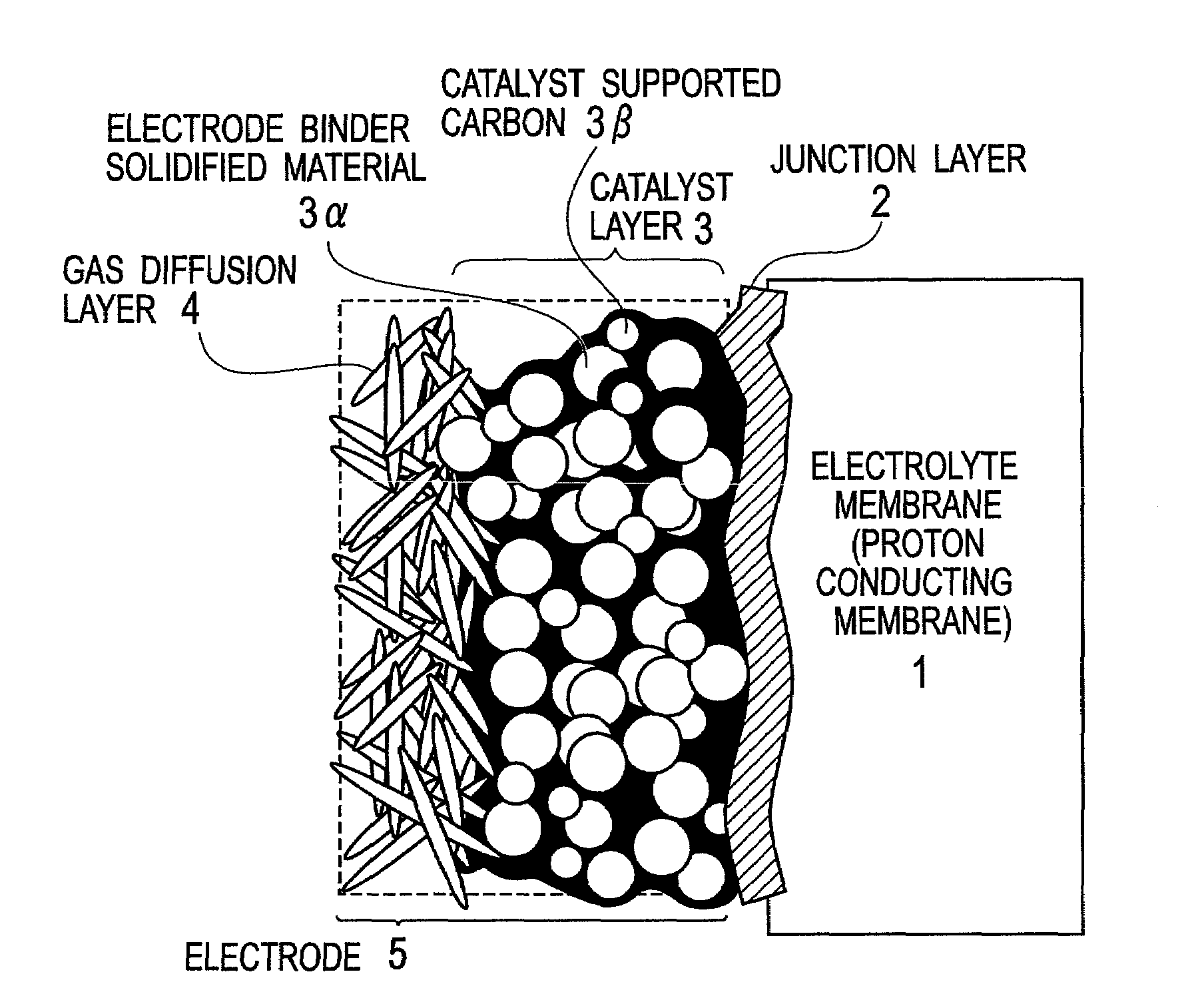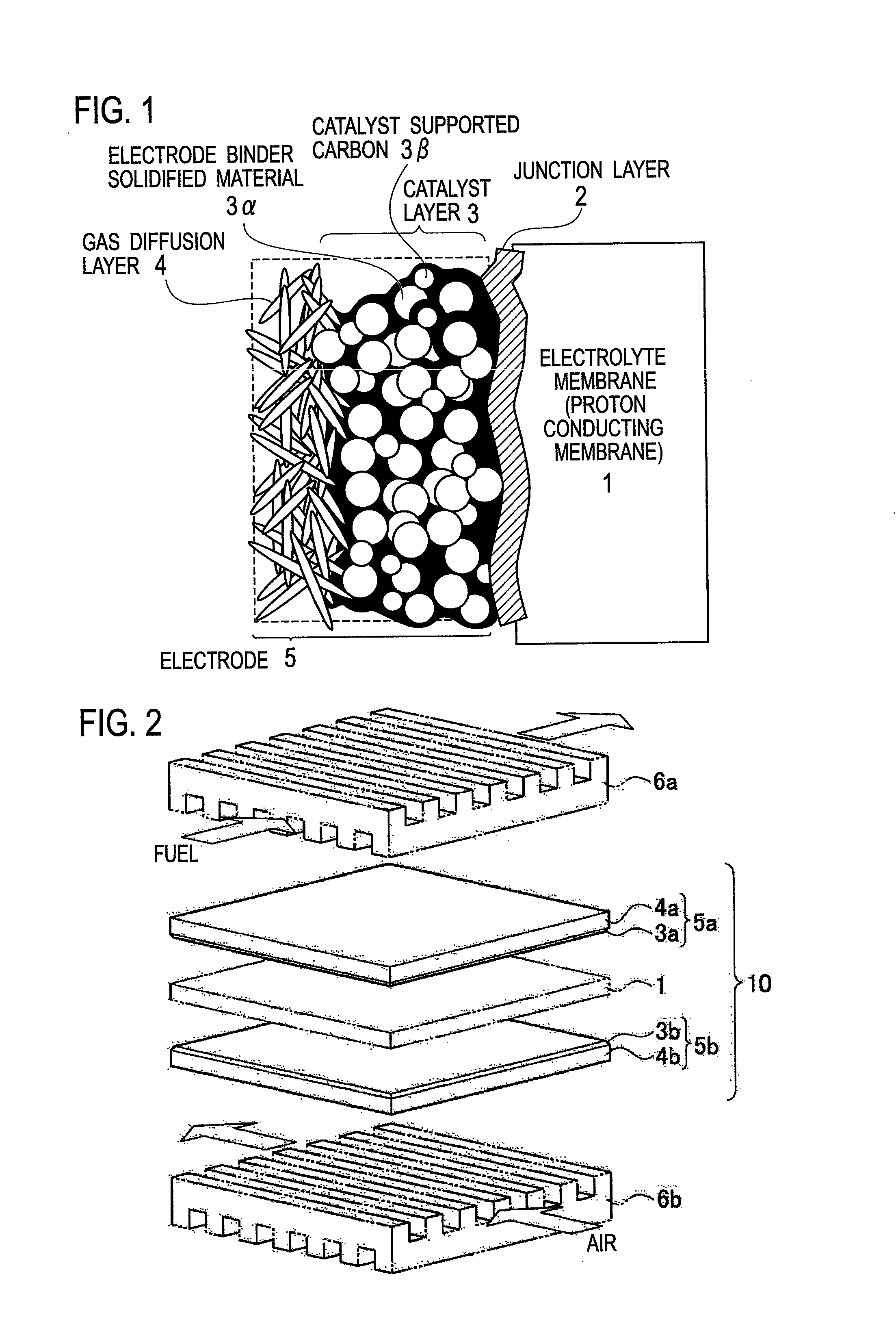Electrode binder, electrode, membrane-electrode assembly and polymer electrolyte fuel cell
a technology of electrolyte fuel cell and electrode, which is applied in the direction of non-aqueous electrolyte cells, cell components, electrochemical generators, etc., can solve the problems of short heat resistance of sulfonated fluorine resin having the thermoplasticity, reducing ion conductivity, and breaking of ion channel structures, so as to improve power generation performance and high durability
- Summary
- Abstract
- Description
- Claims
- Application Information
AI Technical Summary
Benefits of technology
Problems solved by technology
Method used
Image
Examples
example 1
1-1. Fabrication of Gas Diffusion Layer
[0174]A porous conductive sheet (TGP-H-060, made by Toray Industries Inc.; Thickness: 190 μm) was impregnated into an aqueous solution of Neoflon ND-1 (made by Daikin Industries Ltd.), and the impregnating was done repeatedly until its weight reaches to 10 to 15 wt %. Thereafter, a resultant thus obtained was heated at 300° C. for 30 minutes (water-repelling treatment) . . . . S111
1-2. Production of Catalyst Ink
[0175]2.0 g of poly(2-acrylamide-2-methylpropane sulfonic acid) (in which a 15% aqueous solution made by Sigma-Aldrich Corporation was diluted by water to 2.5%), 0.3 g of catalyst supported carbon (for the cathode, platinum supported carbon: TEC10E50E made by Tanaka Kikinzoku Kogyo K. K.; Pt 48%, for the anode, platinum-ruthenium supported carbon: TEC61E54 made by Tanaka Kikinzoku Kogyo K. K.; Pt 30% Ru 23%, were used) were mixed. In the mixing, an ultrasonic homogenizer was used.
[0176]0.6 g of tetramethoxysilane was added to the mixture...
example 2
2-1. Fabrication of Gas Diffusion Layer
[0180]A diffusion layer was fabricated in a similar way to S111 of Example 1.
2-2. Production of Catalyst Ink
[0181]2.0 g of the poly(2-acrylamide-2-methylpropane sulfonic acid) (in which a 15% aqueous solution made by Sigma-Aldrich Corporation was diluted by water to 2.5%), 1.0 g of poly(styrene sulfonic acid) (in which a 18% aqueous solution made by Sigma-Aldrich Corporation was diluted by water to 2.5%), 0.3 g of the catalyst supported carbon (for the cathode, platinum supported carbon: TEC10E50E made by Tanaka Kikinzoku Kogyo K. K.; Pt 48%, for the anode, platinum-ruthenium supported carbon: TEC61E54 made by Tanaka Kikinzoku Kogyo K. K.; Pt 30% Ru 23%, were used) were mixed. In mixing, the ultrasonic homogenizer was used.
[0182]0.6 g of the tetramethoxysilane was added to the mixture described above, followed by mixing using the ultrasonic homogenizer. Furthermore, 0.5 g of the isopropyl alcohol was added to the resultant, followed by mixing u...
example 3
3-1. Fabrication of Proton Conducting Membrane
[0186]0.12 g of water and 0.060 g of triethylamine were dropped into a liquid obtained by mixing 4.07 g of a copolymer (X-41-1805, made by Shin-Etsu Chemical Co., Ltd.) of 3-mercaptopropyl trimethoxysilane and tetraethoxysilane and 1.0 g of the tetraethoxysilane with each other. A resultant solution was stirred at the room temperature for 20 minutes until becoming transparent, and was thereafter developed on a fluorine film. On this solution, a polyethylene-made porous material (average pore diameter: 0.5 μm; thickness: 50 μm; cut into a square with a side of 10 cm) was covered, and the porous material was impregnated with this liquid. The liquid was impregnated into the porous material by using a polyethylene-made pallet so as not to cause unevenness. Thereafter, such a membrane obtained after the impregnation was covered with a fluorine resin film, and an applicator was allowed to level this resultant from the above so that a membrane ...
PUM
| Property | Measurement | Unit |
|---|---|---|
| temperature | aaaaa | aaaaa |
| Tg | aaaaa | aaaaa |
| particle size | aaaaa | aaaaa |
Abstract
Description
Claims
Application Information
 Login to View More
Login to View More - R&D
- Intellectual Property
- Life Sciences
- Materials
- Tech Scout
- Unparalleled Data Quality
- Higher Quality Content
- 60% Fewer Hallucinations
Browse by: Latest US Patents, China's latest patents, Technical Efficacy Thesaurus, Application Domain, Technology Topic, Popular Technical Reports.
© 2025 PatSnap. All rights reserved.Legal|Privacy policy|Modern Slavery Act Transparency Statement|Sitemap|About US| Contact US: help@patsnap.com



